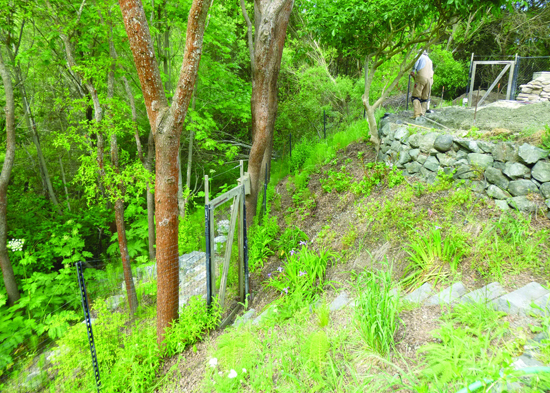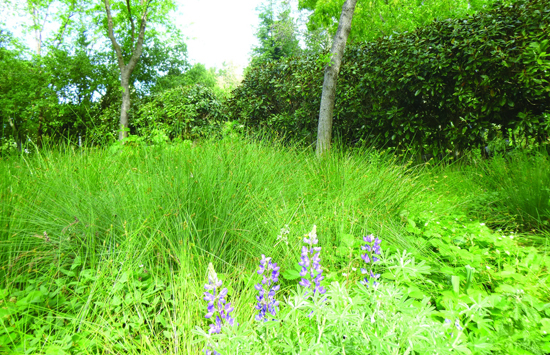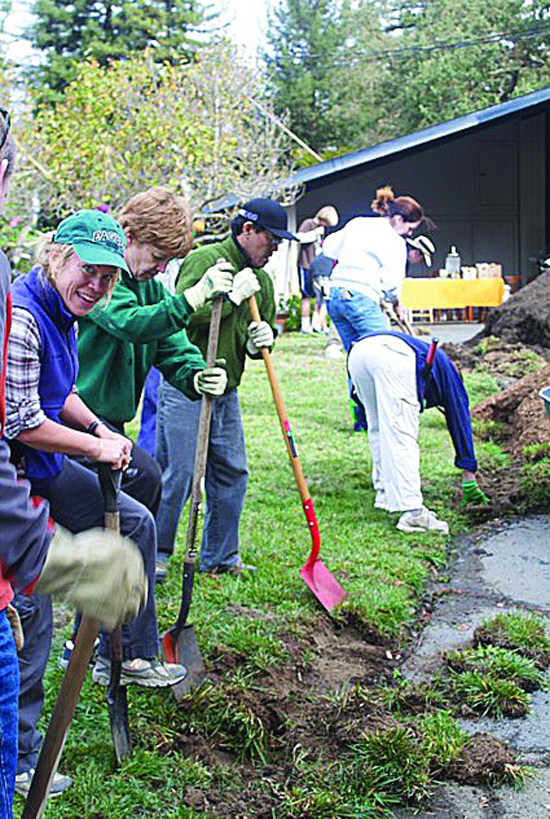| | Published April 24th, 2013
| Bringing Back the Natives Goes Hands On
| | By Sophie Braccini |  | | The Sorensons' creek restoration
|
It is quite remarkable, driving along Sleepy Hollow streets on the way to Bob and Stephanie Sorenson's, to witness the number of homes that have foregone front lawns for native/Mediterranean/low-irrigation plant displays. While most of them are not part of this year's annual Bringing Back the Natives Tour on May 5, they are testimony to Lamorinda residents' growing desire to save water and conform to native vegetation.
 The Bringing Back the Natives Garden Tour encourages such efforts, allowing residents a way to visit some of the most beautiful native gardens around. This year there will also be a series of hands-on 'Select Tours' offered before and after the free self-guided tour, where participants can learn techniques to help them create their own native gardens.
The Bringing Back the Natives Garden Tour encourages such efforts, allowing residents a way to visit some of the most beautiful native gardens around. This year there will also be a series of hands-on 'Select Tours' offered before and after the free self-guided tour, where participants can learn techniques to help them create their own native gardens.
 "I had the idea of the Select Tours for people who want to see more gardens or who want to learn something about a specific theme," says tour organizer Kathy Kramer. "The objective is to help people move ahead, on their own." For example, six months ago the Bringing Back the Natives Garden Tour held a "Mow no Mo'!" sheet mulching workshop at Craig Somberg's garden in Lafayette, and 1,750 square feet of lawn disappeared in one day.
"I had the idea of the Select Tours for people who want to see more gardens or who want to learn something about a specific theme," says tour organizer Kathy Kramer. "The objective is to help people move ahead, on their own." For example, six months ago the Bringing Back the Natives Garden Tour held a "Mow no Mo'!" sheet mulching workshop at Craig Somberg's garden in Lafayette, and 1,750 square feet of lawn disappeared in one day.
 Kramer said that people came with their gloves and shovels to help and to learn how to do it. Afterward, Somberg's garden was ready for drip irrigation and a Smart Timer to be installed, and for the plants to get into the ground.
Kramer said that people came with their gloves and shovels to help and to learn how to do it. Afterward, Somberg's garden was ready for drip irrigation and a Smart Timer to be installed, and for the plants to get into the ground.
 There are some old favorites on this year's tour, like Al Kyte's garden in Moraga. Kyte has been a native gardener for 40 years and has a wealth of information. There are also several new Lamorinda participants on the tour, including the Sorensons.
There are some old favorites on this year's tour, like Al Kyte's garden in Moraga. Kyte has been a native gardener for 40 years and has a wealth of information. There are also several new Lamorinda participants on the tour, including the Sorensons.
 Bob Sorenson was raised in Orinda and grew up by a creek; he moved to his current house in 1989. "I wanted to buy a home with a creek and to be part of nature," he said. "The creek behind my house must have been grazed by cattle at some point and was invaded by weeds. I started learning about the native plants and over the years replaced the weeds with natives."
Bob Sorenson was raised in Orinda and grew up by a creek; he moved to his current house in 1989. "I wanted to buy a home with a creek and to be part of nature," he said. "The creek behind my house must have been grazed by cattle at some point and was invaded by weeds. I started learning about the native plants and over the years replaced the weeds with natives."
 It took Sorenson 10 years to restore the creek to its original state. As he learned about native plants, Sorenson also collected seeds in the San Pablo watershed and learned to propagate the plants. Once the creek project was complete, he started talking to his wife about replacing the front lawn.
It took Sorenson 10 years to restore the creek to its original state. As he learned about native plants, Sorenson also collected seeds in the San Pablo watershed and learned to propagate the plants. Once the creek project was complete, he started talking to his wife about replacing the front lawn.
 At first she was happy with the European-looking front lawn, but as her desire to attract birds and wildlife to her garden grew, she learned that native plants are the best way to do it. "She gave me the okay 18 months ago," said Sorenson. He planted native oaks as the backbone of the garden. Then Sorenson started collecting more seeds and propagating more plants.
At first she was happy with the European-looking front lawn, but as her desire to attract birds and wildlife to her garden grew, she learned that native plants are the best way to do it. "She gave me the okay 18 months ago," said Sorenson. He planted native oaks as the backbone of the garden. Then Sorenson started collecting more seeds and propagating more plants.
 "I propagated 6,000 plants over a one-year period," he said. "Ninety percent of the plants in my front yard meadow I grew myself." All the Ruch Grass of the front lawn came from the propagation of a single plant that was growing in the creek.
"I propagated 6,000 plants over a one-year period," he said. "Ninety percent of the plants in my front yard meadow I grew myself." All the Ruch Grass of the front lawn came from the propagation of a single plant that was growing in the creek.
 At this time of year, the front yard is a lush and charming tapestry of greens and little flowers. Cow parsnips (Heracleum maximum) are about to bloom and are quite dramatic.
At this time of year, the front yard is a lush and charming tapestry of greens and little flowers. Cow parsnips (Heracleum maximum) are about to bloom and are quite dramatic.
 "The garden will change over the year; that's what native gardens do," said Sorenson. "In six months we'll cut the grasses back and it will come back next spring. It will keep evolving." Sorenson added that he does not plan to water the garden and just lets it "do its thing."
"The garden will change over the year; that's what native gardens do," said Sorenson. "In six months we'll cut the grasses back and it will come back next spring. It will keep evolving." Sorenson added that he does not plan to water the garden and just lets it "do its thing."
 "The key to success with native plants is to know when to plant, preferably in October, and to give them just enough water during the first cycles," added Elizabeth Boyle, who lives close to the Sorensons and witnessed their progress before deciding to replace her own front lawn with a beautiful native flower display.
"The key to success with native plants is to know when to plant, preferably in October, and to give them just enough water during the first cycles," added Elizabeth Boyle, who lives close to the Sorensons and witnessed their progress before deciding to replace her own front lawn with a beautiful native flower display.
 "(The Sorenson's) garden is a fine example of the creativity of the people in our region," said Kramer. "Every year I feel blessed to discover new gardens, some of them that have been planted by people who came to the Tour a few years ago." Last year the Tour attracted more than 6,000 visitors; 14,257 garden visits were made on the day of the tour.
"(The Sorenson's) garden is a fine example of the creativity of the people in our region," said Kramer. "Every year I feel blessed to discover new gardens, some of them that have been planted by people who came to the Tour a few years ago." Last year the Tour attracted more than 6,000 visitors; 14,257 garden visits were made on the day of the tour.
 According to Kramer, 75 percent of registrants who attended a previous Bringing Back the Natives Garden Tour said they changed their gardening practices because of their participation.
According to Kramer, 75 percent of registrants who attended a previous Bringing Back the Natives Garden Tour said they changed their gardening practices because of their participation.
 Kramer is not surprised by the spread of the native gardens in our region, even if it is not yet considered the standard look. "A four-year study of water use, green waste generation, maintenance hours, and maintenance labor costs between a traditional garden and a California native plant garden was conducted by the city of Santa Monica," she says.
Kramer is not surprised by the spread of the native gardens in our region, even if it is not yet considered the standard look. "A four-year study of water use, green waste generation, maintenance hours, and maintenance labor costs between a traditional garden and a California native plant garden was conducted by the city of Santa Monica," she says.
 "The results of this study showed that the native garden used one tenth of the water that the traditional garden did; generated less than 40 percent of the green waste; took 20 percent of the time to maintain; and cost 75 percent less to maintain than the traditional garden." (See http://www.smgov.net/Departments/OSE/Categories/Landscape/Garden-Garden.aspx).
"The results of this study showed that the native garden used one tenth of the water that the traditional garden did; generated less than 40 percent of the green waste; took 20 percent of the time to maintain; and cost 75 percent less to maintain than the traditional garden." (See http://www.smgov.net/Departments/OSE/Categories/Landscape/Garden-Garden.aspx).
 Registration for the free tour closes April 27. This allows Kramer to send every participant a guide that includes the garden addresses, maps and directions as well as a schedule of presentations offered that day. This year, a walk-in sign up was added at the Kyte house, 57 Corliss Dr. in Moraga, where people can pick up the guide to continue the tour from there.
Registration for the free tour closes April 27. This allows Kramer to send every participant a guide that includes the garden addresses, maps and directions as well as a schedule of presentations offered that day. This year, a walk-in sign up was added at the Kyte house, 57 Corliss Dr. in Moraga, where people can pick up the guide to continue the tour from there.
 Cost for Select Tours - "How to Install a Netafim Drip Irrigation System and SmartTimer, Plant California Natives, and Receive up to $500 for Doing So!" from 10 a.m. to 3 p.m. May 18 and "How to Remove your Lawn, Select Native Plants, and Design a Water-conserving, Pesticide-free Garden That Attracts Wildlife" from 10 a.m. to 3 p.m. May 19 - is $30 per person/tour. Pre-registration for Select Tours is mandatory.
Cost for Select Tours - "How to Install a Netafim Drip Irrigation System and SmartTimer, Plant California Natives, and Receive up to $500 for Doing So!" from 10 a.m. to 3 p.m. May 18 and "How to Remove your Lawn, Select Native Plants, and Design a Water-conserving, Pesticide-free Garden That Attracts Wildlife" from 10 a.m. to 3 p.m. May 19 - is $30 per person/tour. Pre-registration for Select Tours is mandatory.
 For more information and to register, visit www.bringingbackthenatives.net.
For more information and to register, visit www.bringingbackthenatives.net.

|
 | | Flowers in Elizabeth O'Shea's garden in Orinda
|  | | The Sorensons' front yard
|  | | "Mow no Mo'" residents tear up Craig Somberg's lawn
| | | | | | | | | |
| | | print story
Before you print this article, please remember that it will remain in our archive for you to visit anytime.
download pdf
(use the pdf document for best printing results!) | | | Comments | | |
| | | | | | | | | | | | | | | | |





